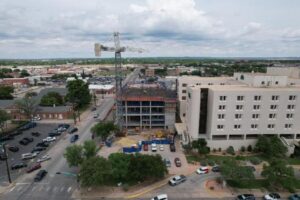Enhancing efficiency, value in healthcare construction projects
In the aftermath of the pandemic, the construction industry has ridden the roller coaster of soaring and plunging input prices. Recent data from Associated Builders & Contractors reveals a glimmer of hope as the latest price index shows a slight decline, but most materials still register substantially higher than pre-pandemic levels. Despite those recent challenges, the healthcare construction sector shines as a beacon of resilience. Analysts predict a 14% jump in year-over-year activity, especially as more hospitals enter planning phases.
As the stakes rise, healthcare builders are harnessing the power of precision planning to keep projects on track and within budget during this period of economic uncertainty. The following are three pivotal areas to stay ahead of the competition while adding exceptional value to projects.
1. The power of collaboration
In the realm of healthcare construction, the foundation of success lies in a proactive and unwavering communication approach with hospital leadership and staff. By establishing a strong working relationship from the beginning with the owner and day-to-day representatives, general contractors can develop a detailed, customized plan that addresses potential disruptions to hospital operations during all phases of construction and make modifications for problems that may emerge during the course of work. At the forefront of this approach is a visit to the hospital in the early days so project leads can get a firsthand view of the workspace and glean insight on how they can successfully integrate their primary tasks within the day-to-day operations of a busy hospital environment.
A prime example of this collaborative effort can be seen at AdventHealth Heart of Florida near Lakeland, where Hoar is renovating and expanding both the hospital’s main entrance and the ER department concurrently. We collaborated with the nursing staff, ER director and facilities director to embark on a comprehensive walk-through of the phasing plan. This allowed us to anticipate potential challenges that were previously unidentified and make vital adjustments that bolstered the efficiency of the overall construction process.
2. Saving time and money with technology
In our quest to maximize efficiency and minimize costs, we are leveraging the power of technology in construction software to streamline construction management on multiple fronts, from easy document searches to expediting the RFI process and facilitating thorough communication among all team members.
During the AdventHealth project, technology proved indispensable when lead time issues threatened a significant delay, necessitating an extension. However, this extension did not align with the hospital ownership team’s needs — so we tapped into the software’s intuitive document search feature, allowing us to create an accelerated schedule that fit within the owner’s specified timeframe.
In addition, Building Information Modeling helps identify potential conflicts and errors early in the design process. When all team members have access to real-time design documents and data, changes can be easily made and distributed instantly, ultimately cutting down on costly errors in design and construction that could put a project in the red.

Aerial construction progress photo of Shannon Medical Center in San Angelo, Texas. Photo credit: Hoar Construction
Another example of technology’s impact is our team’s ongoing renovation of Shannon Medical Center in San Angelo, Texas. Here, the team deployed Bluetooth-enabled sensors embedded in the slabs to monitor moisture levels and verify concrete strength during the meticulous flooring preparation process. The real-time data gathered by these sensors instantaneously transmits to the team’s cellphones, allowing them to plan the stressing of post-tension cables with remarkable efficiency and accuracy.
We’ve also leaned into the use of virtual design & construction. Hoar is utilizing this transformative technology in a multitude of ways, from virtually representing a project to a client pre-construction, creating interactive logistics plans and modeling MEPs to ensure seamless in-field coordination.
BIM processes and VDC tools allow us to represent, visualize, analyze and optimize design and construction information for projects of all types and sizes. BIM/VDC has proven to increase the quality of the design, the plan for construction and, ultimately, reduce project schedule durations and costs. These results have been consistently demonstrated on projects around the world. BIM/VDC is only successful if it follows clear business objectives for the project and is implemented in a disciplined and consistent way among the relevant project participants. We believe it is crucial to develop project-specific BIM execution plans so all stakeholders know who is responsible for what, and when, during the coordination process. These plans allow everyone to buy in to the outlined BIM guidance, while also providing a clear and full understanding of their responsibilities throughout the process.
3. Adjusting plans in real-time
Schedules and budgets are often designed in a manner that makes a change in midstream challenging. To help mitigate this reality, we have embraced a hands-on approach that involves the team immersing themselves in every last detail of our healthcare facility projects. We traverse the halls, meticulously scrutinizing existing conditions and adapting plans in real time.
By comparing the construction drawings with the actual site conditions, we can swiftly detect any discrepancies and make necessary adjustments promptly. The intricate process of healthcare construction always has potential for unexpected discoveries, even from the simplest conversations. Engaging with the lead nurse can help team members sidestep potential landmines early on, such as the pathway designated for patient transportation clashing with barrier plans. No stone is left unturned, which is more important than ever given today’s economic environment. With this amount of unyielding dedication, healthcare builders can ensure projects align well with the evolving needs of healthcare facilities and stay on top of any last-minute changes to project plans.
In an era marked by economic volatility and fluctuating construction input prices, the healthcare sector continues to push forward and set the tone for the broader construction market, with many predicting a bounce back this year. To conquer these unprecedented challenges, general contractors must double down on planning and efficiency by using the above principles as guideposts. By sticking to these three essential strategies, contractors can amplify productivity, minimize disruptions and pave the way for effective outcomes that successfully meet the new challenges of today’s healthcare construction marketplace.
















